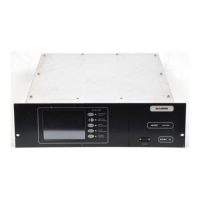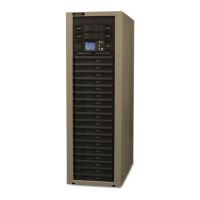toroutputgoesHIGH,U25getsclocked.As
a result, U25 pin 8 goes low.
After a time period determined by R34,
R35, and C11, the output of U26 follows its
input, and goes LOW. The LOW signal
resets U25 via pin 13, the clear input.
U27 and U28 count the number of over-
loads in an approximate 15 second window.
If the counter, U27, counts up to four over-
loads within the 15 second window set by
U28, the power output will step to the next
lowerlevelandlighttheAutomaticCutback
LED.
The stepping back of the power levels is
accomplished by the power level selection
flip flops operating in a shift register mode.
Automatic Cutback occurs when the tri-
state enableline (pin 2 of U7-U12) is pulled
low and the Clock inputs of U4-U6 make a
transistion to a high state. When clocked,
the Q output of the flip flops goes to the
same state as the D input wasat the time the
clock signal occurred. With the way U4-U6
are connected, this results in a progressive
stepping down of the power level as the flip
flops are clocked.
In the event the overload persists even at
a reduced level, the transmitter will con-
tinuetheAutomaticCutbackactionandstep
to the next lower level. If conditions are
good at this level, it will remain there until
manually switched to another level. The
transmitter willnot attemptto goback to the
higher power on its own.
Completely persistent overloads, such as
having no RF drive, will result in the trans-
mitter cycling all the way down to the OFF
condition.
J.1.6. Other Fault Detection
U31 amplifies an input from the PA fuse
detectors, and light an LED corresponding
to which PA module has one or more open
fuses. Under normal conditions, the fuse
sensing circuit of the PA modules will not
affect the voltage at the inputsof U31.How-
ever, if a PA fuse is blown, the fuse detector
circuit will pull the input voltage on U31
low. When the inverting input (-) voltage
goes lower than the non-inverting (+) input,
the output goes positive and energizes the
corresponding PA fuse LED on the front
panel.
U29, U30, U39, and U40 are comparators
for detecting an imbalance in the PDM sys-
tem,and lightthePDM Fault LEDS accord-
ingly. One level of comparators senses that
a PDM Amplifier voltage sample has gone
low.Thiswouldmostlikelybeanindication
ofa shortin aPDM Amplifierwhichhas not
yet caused a PDM Pull Up fuse to blow.
The other level of comparators sense an
open fuse condition. This is done by com-
paring the PDM sample voltage against a
power level reference (PDMREF) provided
by U20. If the sample voltage goes above
the threshold voltage provided by U20, the
corresponding output of the IC illuminates
the LED.
J.1.7. Controller Supply Voltages
Regulators U32 and U33 provide a +/-12
volt source for the Controller board. The
unregulated DC input is a nominal 18 volts.
LEDS DS22 and DS23 provide a front
panel indication of the presence of +/-12
volts.
Various integrated circuitson theControl-
ler board are isolated from the +12 volt line
by a diode. Integrated circuits powered in
this manner have a positive supply desig-
nated as +12A, +12B, +12C, etcetera. The
purpose of this diode isolation is to reduce
the drain on the battery in conditions where
the regulated supply is not present.
The9 voltbatteryholdsthe memorystatus
for the power level settings, fine power ad-
justment, and overload status. A standard 9
volt battery will last about 2 weeks under
continuous operation with no AC power
present.
DS21 is an LED in line with the battery
output. This serves as a steering diode to
isolate the battery from the regular Control-
ler supply, and to serve as an indicator of
excessive current draw from the positive
supply on the Controller. If this LED is on
brightly, there is probably a component on
the board which is drawing an excessive
amount of current.
J.2. Replacement/Alignment Proce-
dures
If you are replacing the Controller board,
or have other reasons to check its setup, the
following section will guide you.
J.2.1. PA Voltage Electrical Zero
Unplug P2 from the PDM Generator so
that there will be no PA voltage when the
high voltage is energized.
Energize the high voltage by depressing
one of the power level buttons. The contac-
tors should energize, and Supply Voltage
should appear on the Multimeter.
AdjustR31 tomakethe PA Voltmeterread
zero.
J.2.2. PA Volt Meter Calibration
The PA volt meter can be calibrated
against an external meter of known accu-
racy, using the following procedure.
WARNING
TURN OFF TRANSMITTER AND DIS-
CHARGE HIGH VOLTAGE BEFORE PRO-
CEEDING.
Routesome long voltmeterleadstothe PA
modules through one of the bottom side
holes made for a cable entrance.
Connect the positive leadof the volt meter
to the 260 volt line of a PA module (L11 or
thefuse,forexample).Connectthe negative
lead to the cathode of CR13 on the PA
board. This is the same electrical point as
the small banana jacks.
Turn the transmitter on at high power.
AdjustR76tomakethefrontpanelPA
voltmeter agree with the external voltmeter.
Turn off high voltage. Allow discharge of
power to zero. Remove voltmeter leads.
J.2.3. Power Supply Current Calibra-
tion
The Power Supply current can be cali-
brated against an external meter using the
following procedure. The external meter
and its leads must be capable of reading at
least 6 amps for a GATES ONE, at least 20
amps for a GATES TWO, and at least 30
amps for a GATES FIVE.
WARNING
ENSURE ALL POWER IS REMOVED
FROM THE TRANSMITTER BEFORE AT-
TEMPTINGTOROUTETHELEADSINTHE
FOLLOWING STEPS.
a. Locate the DC Ammeter where it can be
seen from front of transmitter and route
its leads through one of the bottom side
access holes and up through one of the
wiring grommets, to near the high volt-
age rectifiers.
b. Connect the DC Ammeter in series with
the supply currentshunt resistorA19R7.
This is located to the front of the high
voltage rectifiers. Connect the positive
side of the DCAmmeter to the shunt
(leave the white wire in place on the
shunt).
c. The negative side of the meter should
connect to the black welding cable re-
moved from the shunt.
d. Turn the transmitter on at HIGH
POWER, and adjust the power level to
some convenient calibration level.
e. Note the reading on the external meter,
and adjust R25 on the Controller board
to make the Supply Current reading on
the Multimeter agree with the external
meter reading.
J-2 888-2314-001 Rev.AE: 03-05-2002
WARNING: Disconnect primary power prior to servicing.
